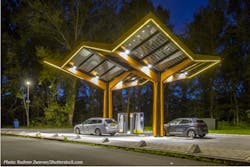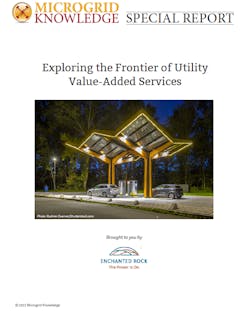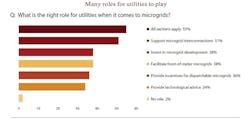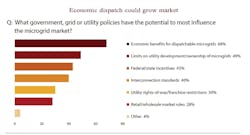Utility execs have microgrids in mind for future value-added services
In a new special report series, utility executives describe their views on developing microgrids and other value-added services.
Download the full report.
For decades, the business of electric and gas utilities has seemed simple enough: provide safe, reliable, and affordable energy to customers in their service territories. But while the oft-repeated elevator pitch is clear, there is plenty of room for interpretation in that mandate. For example, for decades, utilities have offered services that help customers increase their energy efficiency. After all, energy not used is the most affordable energy, making energy efficiency a valuable service.
Value-added services are broadly defined as a utility’s programmatic offerings to customers outside the traditional business of delivering safe, reliable, and affordable system power and gas.
With the imperative to provide sustainable energy increasingly joining the safe, reliable, and affordable mandate, the idea that utilities can provide value-added services beyond just delivering electricity and gas has gained momentum around the United States.
Value-added services are broadly defined as a utility’s programmatic offerings to customers outside the traditional business of delivering safe, reliable, and affordable system power and gas. Examples of value-added services utilities are offering today include support and incentives for:
- Electrification, ranging from support for electric vehicle (EV) charging infrastructure to rebates for EVs, air source heat pumps, and electrified commercial and industrial equipment
- Distributed energy resources (DERs), ranging from battery storage systems to rooftop solar and more
- New approaches to reduce, shift and control electricity use at key times, including demand response, flexible demand, and energy efficiency programs
- Resiliency solutions such as microgrids
In this special report article series, we share results from a survey of utility leaders revealing their views on developing microgrids as value-added services for customers, then explore the vanguard of value-added services related to EVs, DERs, demand response and more offered by six leading utilities from around the country.
Survey Says: Utility Execs Have Microgrids in Mind for Future Value-Added Services
According to a recent survey conducted by Microgrid Knowledge and Enchanted Rock, only 10% of investor- owned utility customers have no interest in microgrids. Many customers have deployed a microgrid or are working to deploy one, with many more in the planning or education phase. The survey results reveal that energy users know about microgrids and see the potential for value.
Most utility leaders surveyed (55%) believe that utilities have a wide-reaching role to play with microgrids — literally “all of the above” — including support for microgrid interconnections, investing in microgrids, helping develop front-of-meter microgrids, incentivizing dispatchable microgrids and advising. Only 2% of those surveyed said utilities have no role to play with microgrids. More than 60% of leaders surveyed said their utilities have deployed or are currently working to deploy a microgrid, with that number jumping to 82% for respondents at IOUs.
Two-thirds of utility leaders said benefits related to electric reliability and backup power was the best reason for their organization to develop a microgrid. That was followed by strengthening the utility distribution system via non-wires alternatives (53%), advancing clean energy and decarbonization (43%), and fulfilling customers’ desires for value-added products and services (42%) as the best reasons to install a microgrid.
High costs or lack of capital (66%) was the most cited deterrent to pursuing a microgrid, followed by two deterrents closely related to costs: regulatory barriers (49%) and lack of support by key stakeholders (30%).
Asked what new policy or market rule had the most potential to grow the microgrid market, 68% said the creation of economic benefits for dispatchable microgrids — a finding that reveals a strong opportunity for microgrid developers and utilities to join forces and advocate together.
Both the utility leader survey results and more in-depth interviews conducted with leaders from the six utilities whose programs are profiled in this report reveal that the policies and preferences of state regulators and lawmakers have a powerful influence on which value- added services each individual utility pursues. For example, Puget Sound Energy serves the greater Seattle area in Washington, home to aggressive state clean energy policies and customers and regulators who support clean energy. Those variables have allowed the utility to seek approval for a sweeping clean energy plan that proposes value-added services for customers in many forms. Rocky Mountain Power, on the other hand, serves territories where state-level clean energy support is less ambitious, and so it is advancing value-added services that can offer other benefits such as greater grid reliability.
Rocky Mountain Power serves territories where state-level clean energy support is less ambitious, and so it is advancing value-added services that can offer other benefits such as greater grid reliability.
In the following chapters, each utility spotlighted offers value-added services across a spectrum of issues important to customers. However, the chapters explore these utilities’ leading value-added services related to one primary objective, such as advancing EVs.
Download the full report “Exploring the Frontier of Utility Value-Added Services,” courtesy of Enchanted Rock to learn more.










